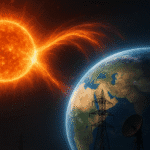Mapping dark matter with gravitational lensing is a groundbreaking approach that has revolutionized our understanding of the universe’s most elusive component. Dark matter, which does not emit, absorb, or reflect light, remains invisible to traditional telescopes. However, its presence can be inferred through its gravitational effects on visible matter, radiation, and the large-scale structure of the universe. Gravitational lensing, a phenomenon predicted by Einstein’s theory of general relativity, provides a unique method to detect and map dark matter by observing how it bends the light from distant galaxies.
The Enigma of Dark Matter
Dark matter constitutes approximately 27% of the universe’s mass-energy content, yet it remains one of the most mysterious substances in cosmology. Unlike ordinary matter, dark matter does not interact with electromagnetic forces, making it invisible and detectable only through its gravitational influence. The concept of dark matter emerged in the early 20th century when astronomers observed discrepancies in the rotational speeds of galaxies. These observations suggested the presence of unseen mass that exerted gravitational forces, preventing galaxies from flying apart.
Over the decades, various theories have been proposed to explain dark matter, ranging from weakly interacting massive particles (WIMPs) to axions and sterile neutrinos. Despite extensive research and numerous experiments, direct detection of dark matter particles remains elusive. This has led scientists to rely on indirect methods, such as gravitational lensing, to study its distribution and properties.
Gravitational Lensing: A Window into the Invisible
Gravitational lensing occurs when a massive object, such as a galaxy cluster, lies between a distant light source and an observer. The gravitational field of the massive object bends the light from the background source, creating distorted, magnified, or multiple images. This effect can be likened to a cosmic magnifying glass, allowing astronomers to study objects that would otherwise be too faint or distant to observe.
There are three main types of gravitational lensing: strong lensing, weak lensing, and microlensing. Strong lensing produces highly distorted images, such as Einstein rings or arcs, and is typically observed in massive galaxy clusters. Weak lensing, on the other hand, causes subtle distortions in the shapes of background galaxies and requires statistical analysis of large datasets to detect. Microlensing involves the temporary brightening of a background star due to the gravitational influence of a smaller foreground object, such as a planet or a star.
Mapping Dark Matter with Weak Lensing
Weak gravitational lensing has become a powerful tool for mapping the distribution of dark matter on cosmic scales. By analyzing the shapes of millions of distant galaxies, astronomers can infer the presence and distribution of dark matter along the line of sight. This technique allows for the creation of detailed dark matter maps, revealing the underlying structure of the universe.
One of the most significant achievements in this field is the Dark Energy Survey (DES), which has mapped the distribution of dark matter over a large portion of the sky. Using a 570-megapixel camera mounted on the Blanco Telescope in Chile, DES has captured images of over 300 million galaxies, providing valuable data for weak lensing analysis. The resulting dark matter maps have confirmed the presence of large-scale structures, such as filaments and voids, predicted by cosmological models.
Challenges and Future Prospects
Despite the success of gravitational lensing in mapping dark matter, several challenges remain. The accuracy of weak lensing measurements depends on precise shape measurements of galaxies, which can be affected by atmospheric distortions, instrumental effects, and intrinsic galaxy alignments. Advanced image processing techniques and sophisticated statistical methods are required to mitigate these challenges and extract reliable information from the data.
Looking ahead, upcoming surveys and space missions promise to enhance our understanding of dark matter through gravitational lensing. The Vera C. Rubin Observatory’s Legacy Survey of Space and Time (LSST) is expected to observe billions of galaxies, providing an unprecedented dataset for weak lensing studies. Additionally, the European Space Agency’s Euclid mission and NASA’s Nancy Grace Roman Space Telescope will offer complementary observations from space, free from atmospheric distortions.
These future endeavors will not only refine our maps of dark matter but also shed light on the nature of dark energy, the mysterious force driving the accelerated expansion of the universe. By combining gravitational lensing data with other cosmological observations, scientists hope to unravel the fundamental properties of dark matter and its role in the evolution of the cosmos.
Conclusion
Mapping dark matter with gravitational lensing has opened a new window into the universe’s hidden realms. This innovative approach has provided compelling evidence for the existence and distribution of dark matter, offering insights into the large-scale structure of the cosmos. As technology advances and new surveys come online, gravitational lensing will continue to be a vital tool in the quest to understand the universe’s most enigmatic component. Through these efforts, we move closer to answering fundamental questions about the nature of dark matter and its influence on the universe’s past, present, and future.










